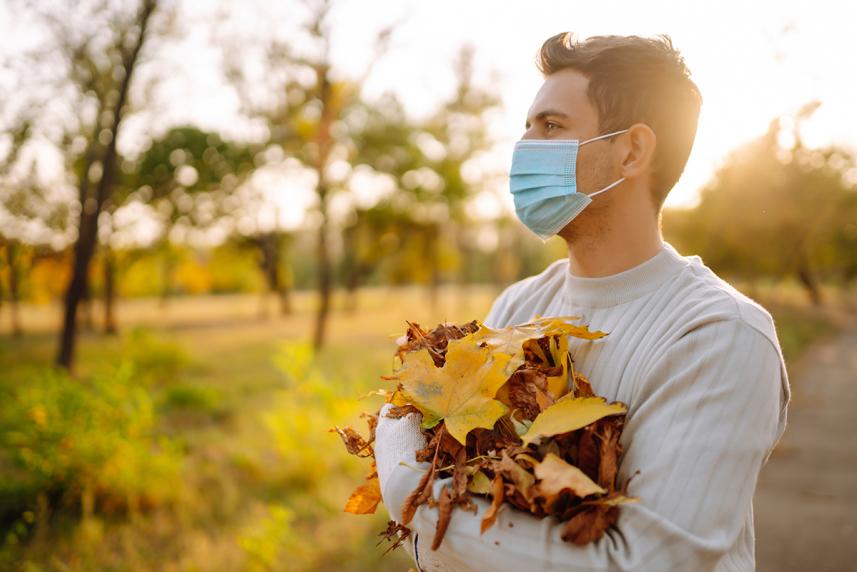What People with Asthma Need to Know About Cold and Flu Season
Don’t let dipping temperatures and germy surfaces keep you out of commission this season.

A cold-weather virus can take anyone out of commission for a few days. But for someone with asthma, a respiratory virus can raise the risk of infection or more lung damage, says Frederick D. Troncales, M.D. Dr. Troncales is a pulmonologist at Franciscan Pulmonary Associates-Burien in Washington state.
To lower your chances of catching a cold, flu, or even COVID-19, put these expert-backed tips to work in your life. Plus, learn how to help ease your symptoms and get back on your feet if a virus does hit.
Practice prevention habits.
If the COVID-19 pandemic has taught us anything, it’s that you can avoid even the nastiest viruses with the right steps. This cold and flu season, flex these healthy habits even harder:
- Wash your hands. The Centers for Disease Control and Prevention (CDC) considers good old-fashioned handwashing to be one of the best ways to keep yourself from getting sick. Research backs that up. One study found that in general, office workers face a 40% to 90% chance of catching a virus. But when they followed a strict clean-hands protocol, that risk dropped below 10%.
Unfortunately, most people don’t scrub long enough to get the full power of soap and water, says Michael W. Sims, M.D. Dr. Sims is an assistant professor of clinical medicine at the University of Pennsylvania School of Medicine. You should wash your hands for a full 20 seconds (think: 2 rounds of humming “Happy Birthday to You”). And make sure to wash your entire hand, including between your fingers and the backs of your hands, the CDC says.
- Keep your distance. Close contact is a common way that viruses spread. Stay away from crowds when possible. And keep some space between you and others when you’re face-to-face. Social distancing works for preventing more than just the COVID-19 virus!
- Get enough sleep. When you’re well-rested, your immune system is better able to fight off invaders, such as cold and flu viruses. One study found that people who sleep less than 6 hours a night are 4 times as likely to get colds as those who sleep 7 hours or more.
- Stay active. It’s tempting to spend your winter curled up under a warm blanket on the couch. But getting some exercise can help you stay healthy. People who exercise moderately are a third as likely to catch a cold as those who don’t exercise, according to research in The American Journal of Medicine. The researchers believe that exercise helps raise levels of white blood cells and proteins that fight off germs. Some examples of moderate exercise to try:
- Brisk walking
- Biking
- Swimming laps
- Doing water aerobics
- Walking stairs
- Washing your car
- Gardening
- Raking leaves
- Dancing
- Eat right and drink up. Eating healthy foods that are high in vitamins and minerals can help keep your immune system humming. So eat plenty of fruits and vegetables. Hydration matters too. The use of saline nasal spray can rinse the nasal passage and helps keep the mucous membranes that line the nose and airways moist. That moisture traps invaders to pass them out of your body.
- Wear your mask. Experts don’t yet agree on how effective face coverings are against spreading the flu. But it can help, especially when done in combination with other practices like handwashing after touching your nose or mouth. Until the COVID-19 pandemic is over, high-risk people may wish to mask up in indoor public places or gatherings and crowded areas, even after they’re vaccinated. As of July 2021, the CDC recommends talking to your healthcare provider about wearing a mask to lower your risk.
- Set up little ones for success too. If you have a school-age child with asthma, you can help them take steps to stay well even while they’re away from you. First, teach them to adopt your same healthy habits for fending off viruses. Next, review your child’s Asthma Action Plan with them regularly so they know how to watch for and respond to common asthma symptoms. Also, share the plan with your child’s teacher so they have all the key information needed to help your child manage their asthma. Finally, make sure your child has access to quick-relief medication (like a rescue inhaler). If they’re not old enough to carry it, you can leave the medication with the school office along with instructions on how to help your child use it.
If you’re struggling to manage your asthma, don’t go it alone. You can get help with your asthma action plan not only through www.lung.org, but directly through BlueForMe, your digital health management tool. This app is included with your health plan and connects you directly with your care team. Call 844-730-2583 to see if you’re eligible for BlueForMe today.
Get your vaccines.
There’s no vaccine for the common cold (yet!). But there are vaccines that can effectively protect you from other viruses that could raise your risk of asthma complications.
- Pneumonia. People with certain lung conditions, such as asthma or COPD, may be at higher risk of pneumonia. There are 2 types of pneumonia vaccines: PCV13 and PPSV23. The CDC recommends that people with chronic lung conditions receive PPSV23.
- Influenza. Each year, scientists predict which strains of the flu will be most dominant. Then they tailor that year’s vaccine as needed. That means you’ll need to roll up your sleeve every flu season to stay protected. But it’s worth it: The CDC estimates that the flu vaccine prevents millions of illnesses and hospitalizations each year. And one study found that even for those who did get sick, adults who were vaccinated were 59% less likely to be admitted to the ICU than those who weren’t vaccinated.
- COVID-19. Chronic lung diseases, such as asthma and COPD, can make you more likely to get severely ill from COVID-19, according to the CDC. You can safely avoid this illness and greatly lower your risk of severe symptoms if you do get the virus. The solution: Get vaccinated with 1 of the 3 vaccines now available in the United States.
Are you up to date on your vaccines? If not, you can always visit cdc.gov/vaccines. Or if you’re not sure, BlueForMe, your digital health management app, can help. Call 844-730-2583 to see if you’re eligible for BlueForMe today.
Make a sick-day and recovery plan.
Despite your best efforts, the cold or flu may still strike. That’s why it’s important to talk to your doctor so you understand:
- How to manage your symptoms. Some over-the-counter (OTC) cold and flu medications, such as aspirin or NSAIDs, may make certain people more prone to an asthma attack. Your doctor should be able to share which medications, if any, can safely help ease your symptoms.
- What supplies to have at home. No one wants to make a drugstore run while they’re contagious and feeling miserable. Your doctor may suggest having an extra asthma inhaler or prescription medications on hand. You might also want to stock electrolytes, tissues, lozenges, and other medicine cabinet staples.
- When to seek treatment. For the flu, a prescription antiviral (such as Tamiflu®) can keep flu viruses from growing in your body. That makes your symptoms milder and your illness shorter. And it can help lower your risk of severe complications.
- When to seek emergency medical care. Anyone with a chronic lung condition needs to know the warning signs that it’s time to get medical care right away. Common warning signs include:
- Difficulty breathing
- Constant chest pain
- Seizures
- Severe muscle pain
- Worsening of a chronic medical condition
This list isn’t comprehensive, and your healthcare team may have other signs they want you to watch for, so be sure to talk about it with them.
What to do afterward. The cold or flu virus may continue to make asthma symptoms worse for a few weeks after virus symptoms are gone. Your doctor may suggest redoubling your efforts to avoid anything that could trigger a flare-up. Common triggers include:
- Tobacco smoke
- Mold
- Dust mites
- Pet dander
- Exercising
- Being in high-humidity environments
Experts will keep looking for ways to stop or cure the flu and common colds. But for now, being prepared — especially if you have a long-term illness such as asthma — is the best thing you can do to stay safe and healthy.
SOURCES:
[1] “Frequent Questions About Hand Hygiene.” CDC, October 14, 2020, https://www.cdc.gov/handwashing/faqs.html. Accessed July 26, 2021.
[2] “Germs Spread Fast at Work, Study Finds.” The University of Arizona, January 30, 1013, https://news.arizona.edu/story/germs-spread-fast-at-work-study-finds. Accessed July 26, 2021.
[3] Prather AA, Janicki-Deverts D, Hall MH, et al. “Behaviorally Assessed Sleep and Susceptibility to the Common Cold.” Sleep, vol. 38, no. 9, 2015, pp: 1353-1359.
[4] Chubak J, McTiernan A, Sorensen B, et al. “Moderate-Intensity Exercise Reduces the Incidence of Colds Among Postmenopausal Women.” The American Journal of Medicine, vol 119, no. 11, 2006, pp: 937-942.
[5] “What Does Moderate Exercise Mean, Anyway?” Cleveland Clinic, October 23, 2020, https://health.clevelandclinic.org/what-does-moderate-exercise-mean-anyway/. Accessed August 20, 2021.
[6] “How to Boost Your Immune System.” Harvard Health Publishing, February 15, 2021. https://www.health.harvard.edu/staying-healthy/how-to-boost-your-immune-system. Accessed July 26, 2021.
[7] “Marvels of Mucus and Phlegm: The Slime That Keeps You Healthy.” National Institutes of Health, NIH News in Health, August 2020, https://newsinhealth.nih.gov/2020/08/marvels-mucus-phlegm. Accessed July 26, 2021.
[8] “Interim Guidance for the Use of Masks to Control Seasonal Influenza Virus Transmission.” CDC, March 5, 2019, https://www.cdc.gov/flu/professionals/infectioncontrol/maskguidance.htm. Accessed July 26, 2021.
[9] “Your Guide to Masks.” CDC, June 29, 2021, https://www.cdc.gov/coronavirus/2019-ncov/prevent-getting-sick/about-face-coverings.html. Accessed July 26, 2021.
[10] “Pneumococcal Vaccination: Summary of Who and When to Vaccinate.” CDC, August 7, 2020, https://www.cdc.gov/vaccines/vpd/pneumo/hcp/who-when-to-vaccinate.html. Accessed July 26, 2021.
[11] “Key Facts About Seasonal Flu Vaccine.” CDC, June 8, 2021, https://www.cdc.gov/flu/prevent/keyfacts.htm. Accessed July 26, 2021.
[12] “Study Shows Flu Vaccine Reduces Risk of Severe Illness.” CDC, August 1, 2018, https://www.cdc.gov/flu/spotlights/2017-2018/vaccine-reduces-risk-severe-illness.htm. Accessed July 26, 2021.
[13] “People with Certain Medical Conditions.” CDC, May 13, 2021, https://www.cdc.gov/coronavirus/2019-ncov/need-extra-precautions/people-with-medical-conditions.html. Accessed July 26, 2021.
[14] “Some OTC Medications Can Trigger Asthma.” U.S. Pharmacist, July 24, 2019, uspharmacist.com/article/some-otc-medications-can-trigger-asthma. Accessed July 26, 2021.
[15] “Common Asthma Triggers.” CDC, August 1, 2020, https://www.cdc.gov/asthma/triggers.html. Accessed July 26, 2021.
DISCLAIMER: Florida Blue has entered into an arrangement with Wellframe to provide members with care decision support services, information and other services. This article is provided by Linkwell Health through their arrangement with Wellframe. Please remember that all decisions that require or pertain to independent professional medical/clinical judgment or training, or the need for medical services, are solely your responsibility and the responsibility of your physicians and other healthcare providers. Wellframe is an independent company that provides online services to Florida Blue members through the Blue for Me app.
